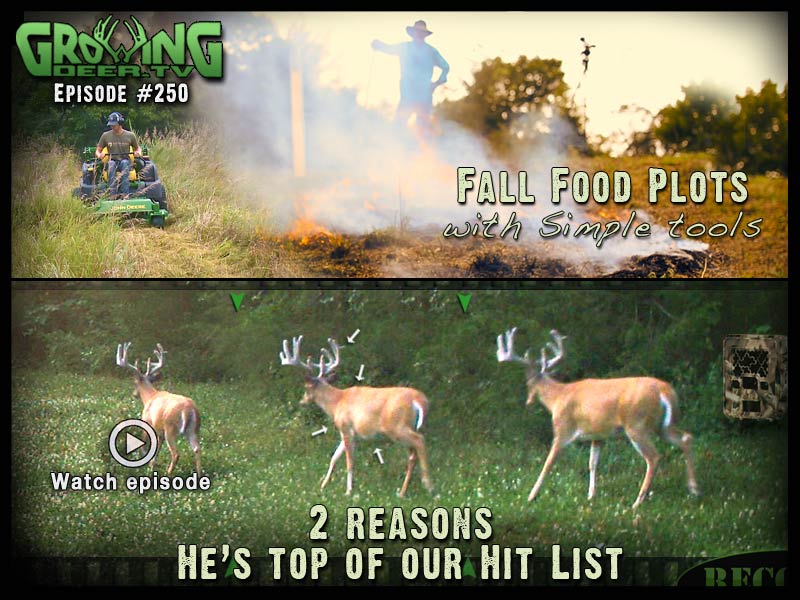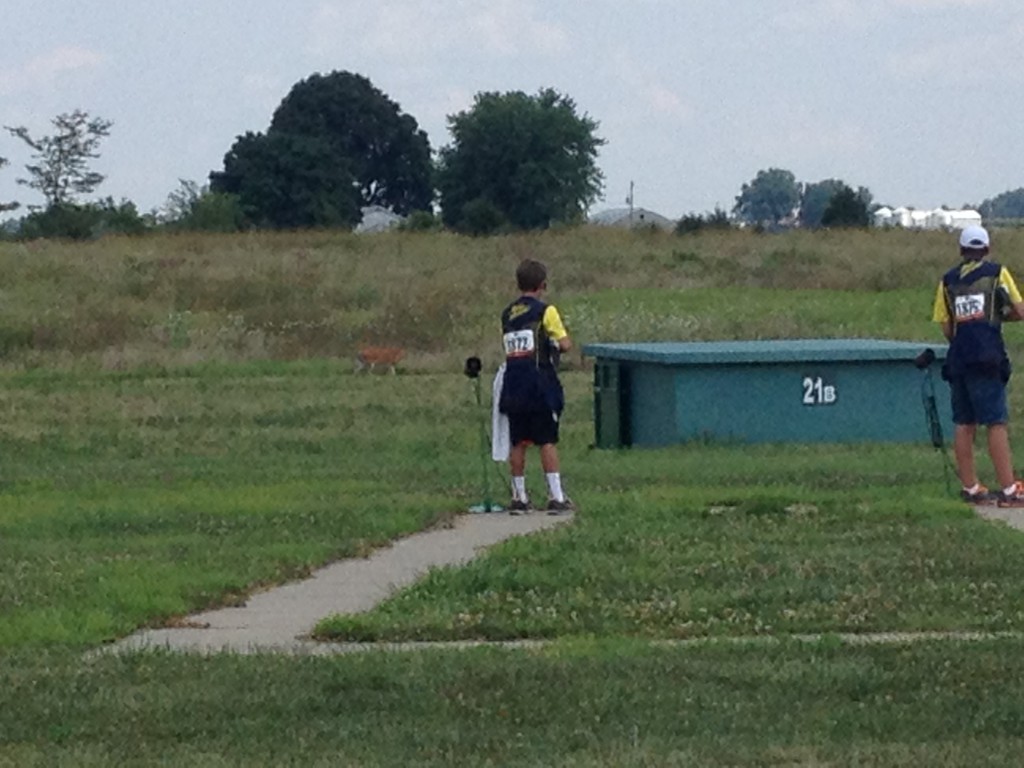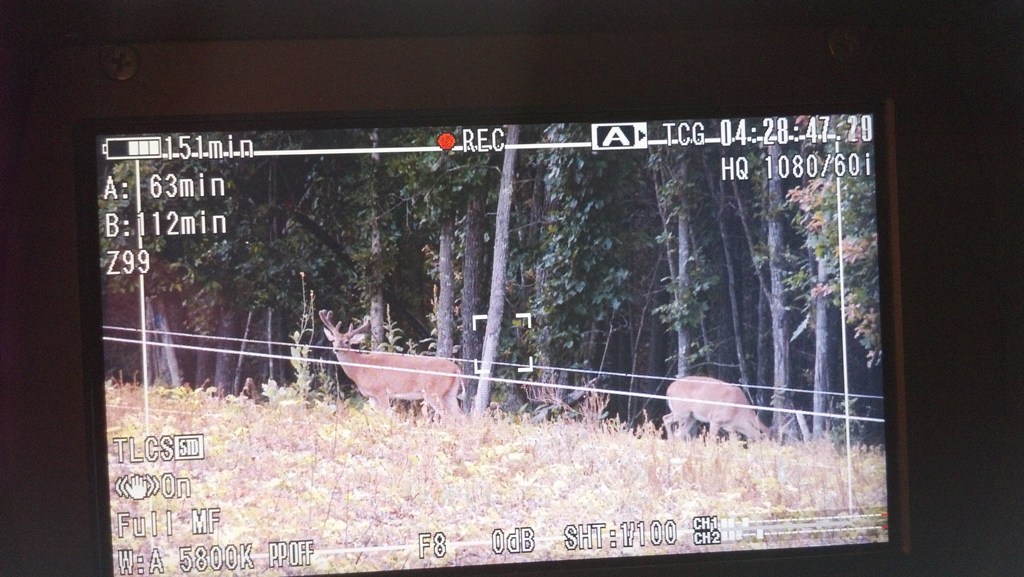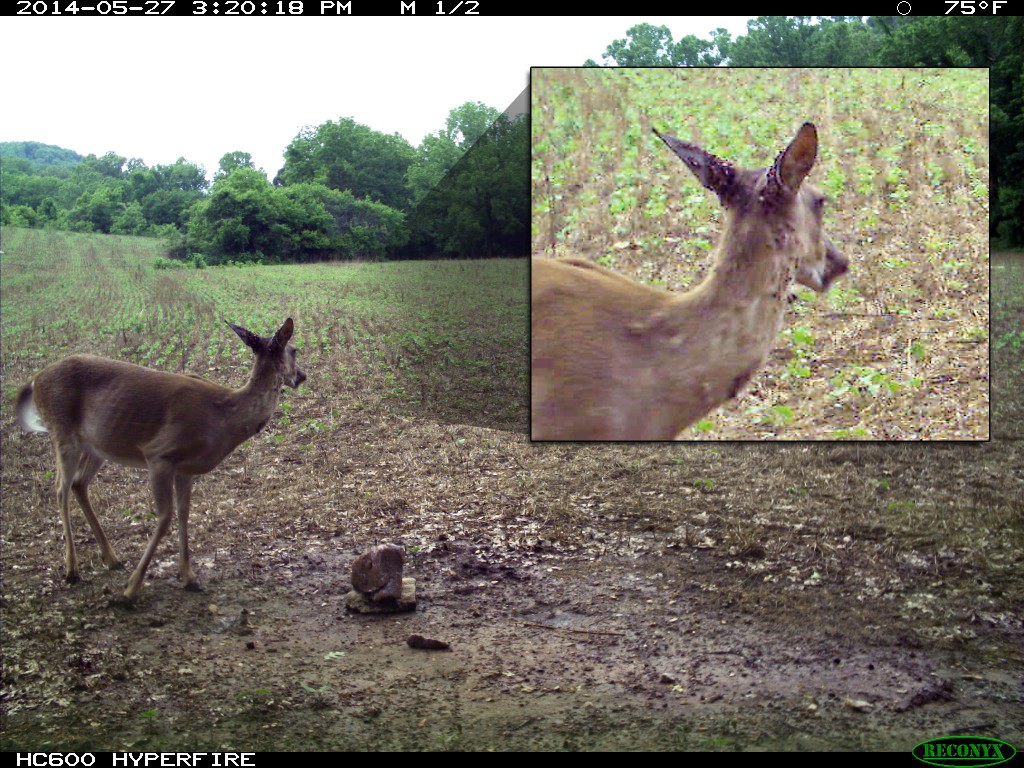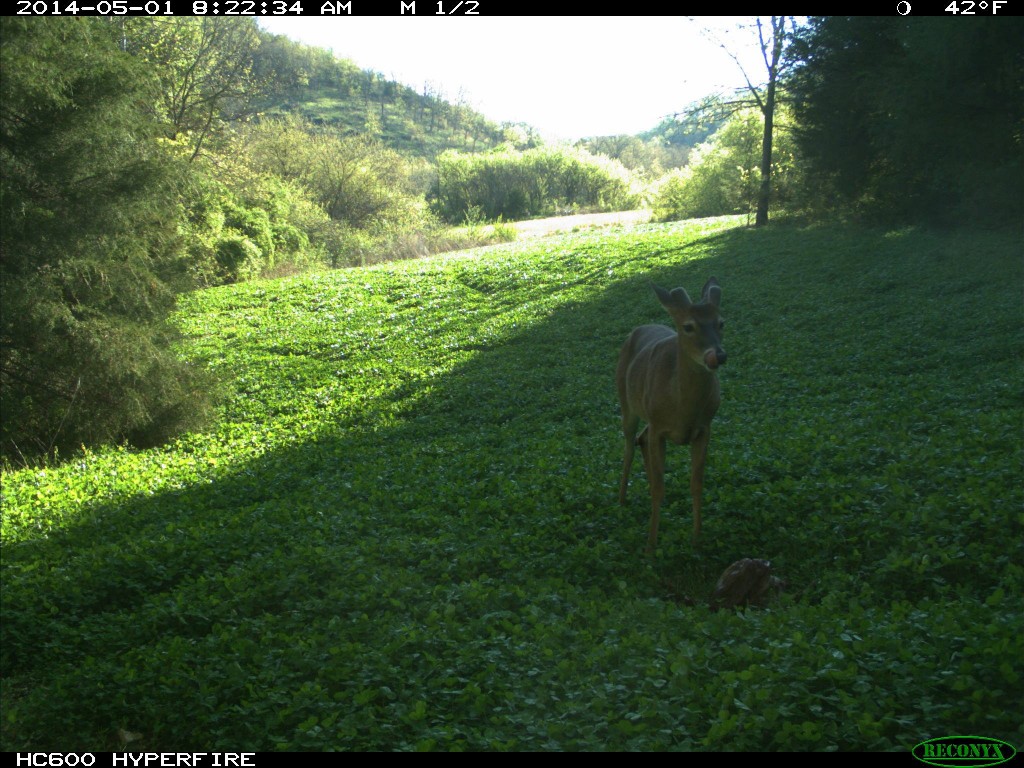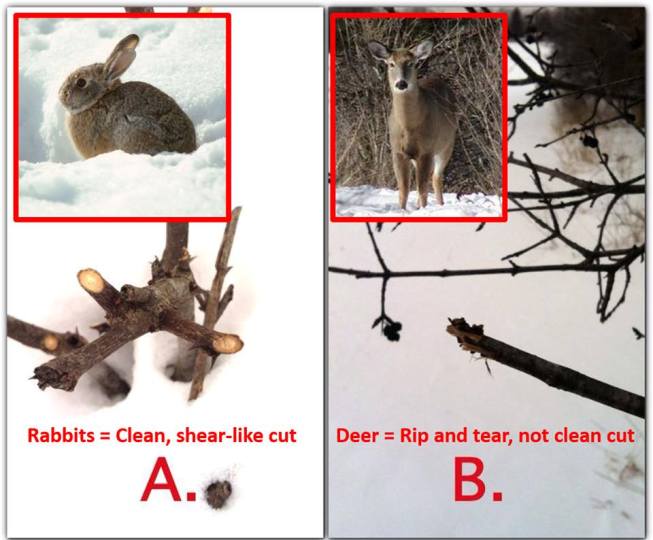Category: White-tailed Deer
Watching Antlers: Preparing For Bow Season
It’s that time of the year when we are changing gears. Missouri’s turkey season just closed. We are not only getting more sleep at night, but also dreaming of whitetails. Our Reconyx cameras have been capturing photos of great antler development here at The Proving Grounds. This is very exciting! We will enjoy watching bucks develop within the next couple months.
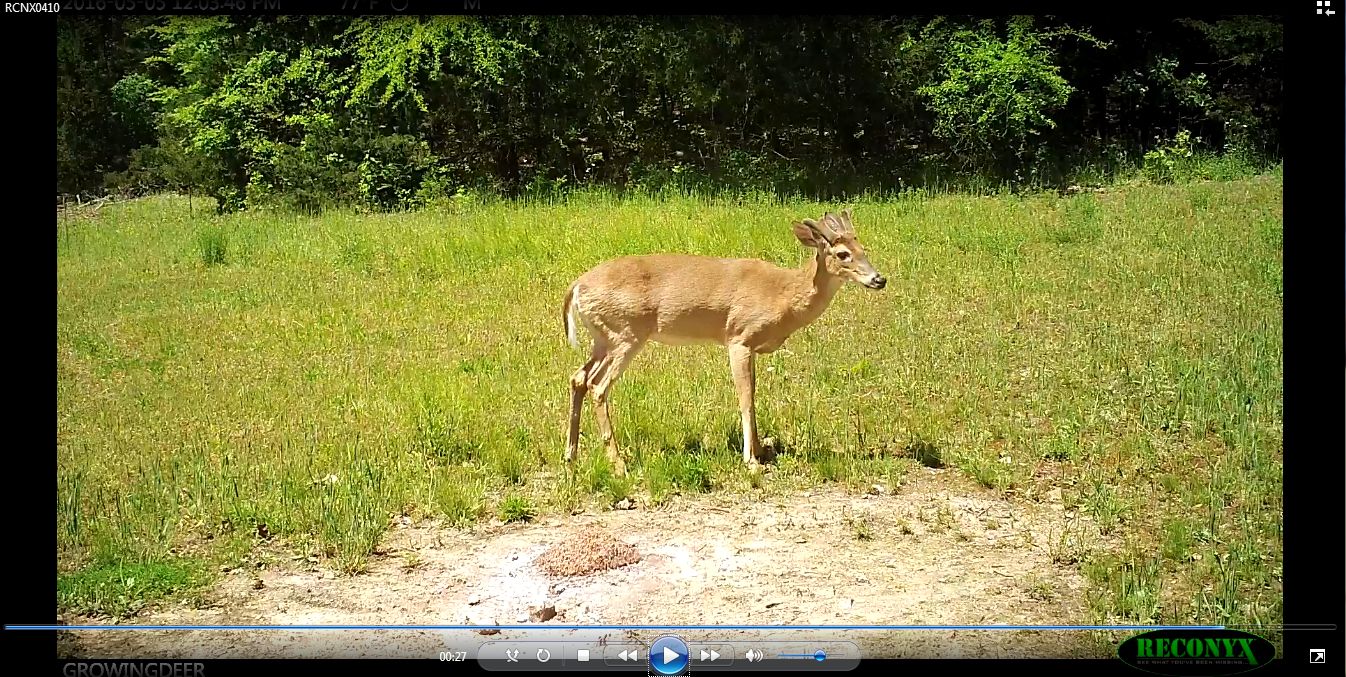
This buck is off to a great start. You can bet we will keep our eye on him this summer!
This is an important time of the year. We take a few additional measures now to better prepare ourselves for hunting season. At this time of the year we move our Reconyx cameras from turkey strut zones to food plots and established Trophy Rock mineral sites. The recently planted Eagle Seed beans will soon attract deer. Positioning cameras on these plots allows us to watch feeding patterns during the summer. Learning these patterns early on can assist as opening day arrives. States with early bow openers like Kentucky, Maryland, or Wyoming have an advantage if summer feeding patterns are identified as season opens.
Mineral sites serve multiple purposes for us. Both bucks and does regularly use mineral locations throughout the summer. These locations are ideal for Reconyx cameras as well. Trophy Rock provides macro and micro trace elements to the local deer herd. As bucks develop their antlers this supply of minerals increases antler growth. This is a stressful time for does as they are dropping fawns and lactating over the next several months. Lactating requires a healthy diet plus additional nutrients to supply to young fawns. Trophy Rock can supply those necessary elements.
Placing cameras over food plots and Trophy Rock locations is a great way to build anticipation. Antler development is occurring while fawns are beginning to drop. Our cameras are in place to capture this all! We are excited to start cataloging bucks! It is a great time of the year for a deer manager.
GrowingDeer together,
Matt
Stressed Out!
Without a shadow of a doubt, the rut is an extremely stressful period for white tail deer, especially bucks. Bucks are on their feet traveling miles each day in search of receptive does. In addition to this, bucks commonly fight during this time of year. A large amount of energy is used during events like this. These types of activities begin to wear down the physical characteristics of bucks specifically. We commonly see from hunting observations and Reconyx trail camera photos drastic weight loss, leg injuries, blindness, and scars across their bodies.
As land managers we can be proactive and provide quality forage that will help bucks recover weight losses that occur during the rut. As soon as the post-rut ends there is a large push for a protein and carbohydrate rich diet to regain weight and energy that will help get them through the winter months. We plant Eagle Seeds Broadside in our plots to provide the quality forage during the fall and winter. In addition, these plots make great hunting locations!
Growing Deer together,
Matt
Newborn Fawns: What To Do When You Find One
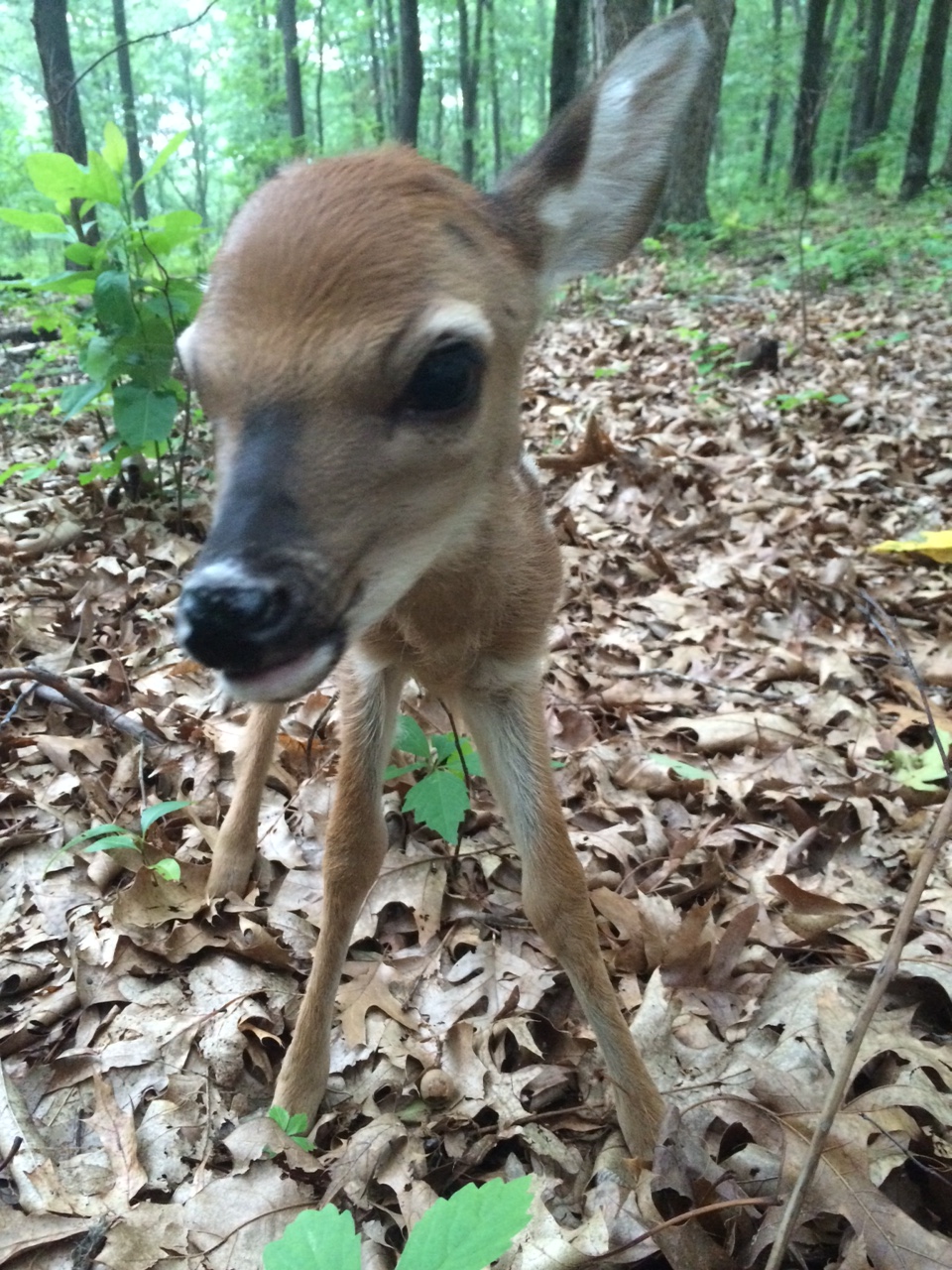
Intern Nick Halchin found this fawn recently. At this stage in life, fawns aren’t as aware of danger as mature deer and can fall to predators very easily.
Throughout most of the whitetail’s range fawns are being born. Predators, weather conditions, etc., can substantially reduce the odds of fawns surviving. In addition, well-meaning humans often also reduce fawns chances for survival.
New born fawns spend about the first ten days of their life in cover, hidden, and almost motionless. Research shows that they are bedded about 95% of the time during this period. Every spring I hear stories of people finding fawns and carrying them home because they didn’t see a doe. A fawn’s chance of survival almost always decreases significantly if removed from where it was placed by a doe.
Predation that occurs on fawns happens the most during these first few days of their life. Human disturbance to where a doe left a fawn adds scent, etc. and can actually attract predators to the fawn. That’s why it’s extremely important people don’t pick up and remove fawns from their hiding place. The doe is most likely close by and chances of survival rapidly decrease if the fawn is taken out of hiding.
Remember, fawns may seem extremely cute and adorable but they belong in the wild. Never pick up a fawn found in the wild. As conservationists it’s our duty to ensure a healthy life for the fawns, and the best way for us to do so is leaving them alone.
Daydreaming of whitetails,
Adam
Antlers Are Back
Antlers are growing and the GrowingDeer Team is excited! As Missouri’s turkey season closes, checking our Reconyx cameras keeps a smile on our faces.
Many bucks have started growing antlers and it is thrilling to see who made it through the winter. It is another enjoyable season. Young bucks will be expressing their potential, making our mouths water, hoping they make it to maturity. New bucks (3.5 years old last year) will be added to the “hit list”. The mature bucks we have hunted year after year will again be fun to watch and pattern, but don’t expect the same antlers as last year.
Antlers can change year to year. It is always exciting to see what a new year will bring. Will a mature buck’s antlers begin to decline with age? Will a young buck’s antlers explode, expressing great potential? As you watch antlers develop this summer, enjoy the time getting to know each individual deer. You will begin to learn their habits, tendencies, and preferences. Each antler is unique, as is each deer.
One deer the GrowingDeer Team looks forward to watching is Two Face. Two Face is at least 10 years old and the relationship we have built over time is incredible. Each encounter, whether hunting (watch episode #269 here) or seeing a new picture, is a special moment.
So, grab your Reconyx cameras and a Trophy Rock! You will not want to miss the next few months. Antlers are growing bigger every day. Will you be watching?
Managing whitetails with you,
Daniel Mallette
Top Of Our Hit List: Butterbean – Episode #250
Our Hit List is getting serious. A big buck called Butterbean is currently at the top of the list. Truth is, there might be a bigger buck running around, but Butterbean is still the number one contender. Watch this episode as Grant shares just how the hit list is shaping up! It’s time to get moving on your fall food plots! They are great attraction areas for harvesting deer, but what if you add a tree plot right within your fall plot? It’s gonna be a killer combination! We’ll show you how.
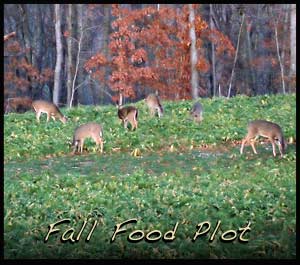 Tip of the Week: Killer Fall Food Plots!
Tip of the Week: Killer Fall Food Plots!
When: Plant your fall food plot 45-60 days before the average first frost in your area.
Ensure Success: When broadcasting seed, ensure enough sun is reaching the soil for seed to germinate and grow. Broadcast seed just before rain.
Our Favorite Fall Blend: Broadside by Eagle Seed
Does Gunshot Noise Spook Deer?
Does the noise of a gunshot spook deer? The answer is “it depends.” I doubt deer are born with knowledge that the noise of a gun or the smell of burnt powder is often associated with danger.
Deer often learn from experiences and other deer to fear many of the sources of danger they face. For example deer certainly run from low flying helicopters when I’m doing aerial surveys in south Texas. However, deer commonly feed close by pads where the helicopter refuels frequently. They’ve obviously learned or been conditioned to accept the helicopter in that area as something that doesn’t present danger whereas the same helicopter flying low over the brush spooks 100’s of deer.
A friend recently shared a great example of how deer learn or can be conditioned to accept or reject smells, noises, etc., as a source of danger. Recently the National Scholastic Clay Trap Program (SCTP) meet was held in Sparta, IL. There were 3,000+ shooters that shot 700,000+ rounds during four days. It was constant shooting from early until late each day.
My friend Dan Appelbaum’s son was participating in the SCTP meet. During a round with shooters up and down the line for literally hundreds of yards deer starting feeding 80 yards or so directly in front of the trap house where Dan’s son was shooting!
The deer didn’t seem overly alert. In fact it distracted the shooters much more than the deer. Clearly the deer living in that area are conditioned to gun shots, the smell of gun powder, gun oil, humans, etc.
I’m sure just a short distance away a gunshot would cause deer to seek cover instantly if it was pointed directly at them.
This same knowledge of deer behavior can be applied to the presence of ATV’s, etc. If deer are conditioned to their presence and don’t have a reason to associate them with danger, it’s doubtful deer alter their activity patterns when they are present. If the source of the disturbance is new then deer probably become very alert and alter their activity patterns. Hunters need to consider these observations when they are scouting and hunting.
Growing Deer together,
Grant
Scouting Bucks In June
Trying to pattern and harvest a mature buck sometimes seems like one of the toughest things to do in the world. They can be so illusive, so particular, and downright paranoid. The good thing about them is they seem to be creatures of habit, especially during the early season. They don’t try many new things and certainly don’t wander down the road (out of their home range) just to see what’s around the corner. With that being said, this is a great time of year to grab a pair of Nikon binoculars and head to the field and spot some bucks in velvet.
Recently I’ve been spending some evenings perched in a Redneck Blind watching over the Eagle Seed beans. Not only am I watching to see the number of deer that are using the beans, but more importantly I’m watching the location of these deer, where they prefer to feed, which areas they avoid, and finally where they enter the field. I monitor where they enter the field the most because this usually doesn’t change a great amount. They may enter the field from a different side on occasion but as a whole they usually approach from the same direction. Do you wonder why they do this? It’s simple, they feel safe this way. The wind currents may be in their favor, they might be able to see the entire field before entering, or maybe it’s the path of least resistance. Whatever the reasons, deer can be patterned by the way they approach a field.
This week I took two of our summer interns and headed to a plot we call Raleigh’s field. We have a 15 foot Redneck blind positioned on the eastern end of the field and we knew some bucks were using the area because of our Reconyx camera. We ended up seeing nine bucks and three does. A couple of the bucks were really nice! It was a great night, but what made the night even better was watching all nine bucks enter the field on the same trail. After watching all of this unfold I can guarantee you that over the next couple months we will be hanging a Muddy stand near that trail hoping to tag a nice buck come September!
It’s a great time of year to get out and scout some bean fields and locate some velvet bucks! Get out there and nail down that opening day location!
Daydreaming of whitetails,
Adam
Prescribed Fire Can Reduce Predators And Improve Deer Hunting
Its fawning season and many fawns will be killed by predators. There’s often a substantial difference between the number of fawns born and the number that survive until six months of age. That’s why most biologists use the term “recruitment” to describe the number of fawns that survive to six months of age.
During the past few years there have been studies by many universities that show coyote and bobcats can kill a high percentage of fawns, even in areas with good hiding cover. More and more landowners are acting to balance the predator and prey populations on their property as a deer and turkey management tool.
Unfortunately, most landowners ignore the most numerous predator – ticks. The Center for Disease Control reports that cases of tick borne illness in humans have been increasing for a decade. Most studies indicate that tick populations are increasing.
Some folks are fast to blame increasing deer populations for the increasing tick populations. This is odd given many deer populations are decreasing throughout the whitetail’s range. Tick populations are strongly influenced by the quality of their habitat in addition to available hosts.
Simply stated 50 deer can feed as many ticks as 100 deer! However, very few ticks survive without good habitat. What is good tick habitat? You might be surprised to learn that moisture is one of the primary ingredients of good tick habitat. A deep layer of leaves, fields of grass that are rarely mowed/burned, or any layer of vegetation that holds moisture can be good tick habitat.
This is because ticks require moisture to survive. If ticks become dry (desiccated) they die rapidly. Researchers have shown that proper use of prescribed fire is an effective tool to reduce tick populations. Fire can remove duff layers (organic matter of fallen leaves, etc.) and moisture for long enough to cause ticks to desiccate. However, ticks will repopulate the area once a duff layer develops. Ticks will be brought into the area on mammals seeking the lush vegetation resulting from the fire.
To significantly reduce tick populations often requires the uses of prescribed fire on an annual or bi annual basis.
Growing and managing deer together,
Grant
Trail Cameras Reveal Large Antlers Starting To Form!
It can be a depressing time of year for some people now that turkey season is wrapping up and the heat of summer is rapidly approaching! That’s not the case for the Growing Deer team as we started checking our Reconyx cameras! We are finding that bucks are already showing antler growth! Bucks have started showing up more regularly at our Reconyx stations, so tracking their growth will be exciting throughout the summer and into the fall.
One of the biggest factors in being able to following their progress is the use of Trophy Rocks. Trophy Rocks are one of the most attractive things you can use to lure deer in front of your cameras allowing you to monitor herd health, fawn survival, and antler growth. We use Trophy Rocks on The Proving Grounds year round, but a lot of people overlook the importance of having Trophy Rocks out during the spring because it isn’t hunting season. As a deer manager don’t forget that having the appropriate minerals and nutrition out year round will not only increase antler size and fawn survival but ultimately result in healthier deer.
Not only are Trophy Rocks great for improving deer health but they also make for some great Reconyx pictures! Stay with us this summer as we share the continual growth of our buck’s antlers!
To learn more about Trophy Rocks go to http://www.trophyrock.com/.
Daydreaming of whitetails,
Adam
Are Deer Eating Your Shrubs And Landscape Plants?
Obviously it has been a tough winter for a lot of people. There have been measurable amounts of snow across the nation throughout the winter and in a majority of the northern states there has been snow covering the ground for months now. This has brought up the topic of deer stress levels and what the deer are feeding on to survive.
I’ve seen several pictures of deer in suburbs and in yards eating shrubs and other decorative plants. Deer have been pushed to areas where they haven’t been all year because they have eaten all the forage available. As deer managers, it’s important to understand what your deer herd is consuming. During these late winter months Grant and I like to explore our food plots and areas with native browse and study the amount of food remaining and what their preference is. It’s also important to understand what exactly is feeding on these plants.
While you’re walking your property and examining the browse pressure you need to understand the difference in deer browse and other types of animal browse. Recently we posted a couple pictures on our facebook page asking our fans the difference between rabbit browse and deer browse. A lot of people were unsure about the difference between the two so I thought I’d explain it more here. The easiest way to tell the difference between the two is if the browse has been cut or torn. Deer don’t have incisors on their upper jaw. They bite on browse with their lower incisors and press against the roof of their mouth and tear off a bite. This results in frayed ends of browse when deer are the consumers. When the consumer is a rabbit, the food source will look like it was cut with a sharp edge, like a knife, as they have sharp incisors on both the lower and upper jaws.
Once you understand the difference between deer browse and rabbit browse you’ll better understand what’s eating your food on your hunting property.
Hopefully the winter weather gives you a break this week and you can get out and look for shed antlers!
Daydreaming of whitetails!
Adam



